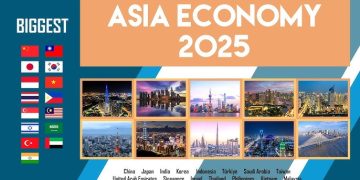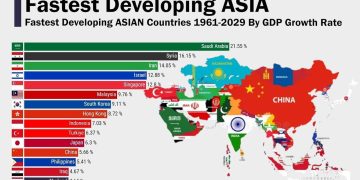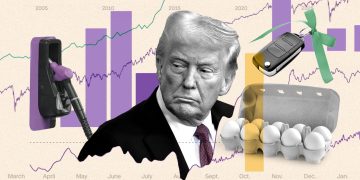1. A Cooling Engine
By mid-2025, the U.S. economy is showing unmistakable signs of deceleration. After a surprisingly resilient 2023–2024 expansion — fueled by fiscal stimulus, pent-up consumer demand, and the technology investment boom — the pace of growth is grinding lower.
According to the IMF’s April 2025 update, U.S. GDP growth is expected to slow to around 2.1% in 2025, down from 2.5% in 2024, with projections pointing toward a further easing into 2026.
What is remarkable is not the slowdown itself, but the nature of the deceleration: broad-based, structural, and gradual — like a great machine losing torque rather than seizing up.
Consumer spending, long the engine of U.S. economic dynamism, is softening. Real wage growth has stalled as inflation, while easing, remains sticky in services. Retail sales, adjusted for inflation, have flattened, and the household savings rate — which spiked during the pandemic — has normalized to pre-2019 lows.
Meanwhile, businesses are holding back on capital expenditures amid uncertain demand, elevated borrowing costs, and geopolitical unpredictability.
2. Labor Market: Tight but Tiring
For two years, America’s job market appeared almost superhuman — consistently generating over 200,000 new jobs per month even as rates climbed. But 2025 marks the beginning of normalization.
Job openings have fallen below 8 million for the first time since 2021, labor force participation has plateaued at 62.7%, and wage growth is slowing from 4% to 3% year-on-year.
While these numbers still reflect relative strength, the underlying composition is shifting: high-skill, high-productivity sectors such as tech and professional services are expanding, while retail, construction, and manufacturing show early signs of fatigue.
Automation and AI are also subtly reshaping employment dynamics. A Goldman Sachs study estimates that AI integration could affect up to 25% of tasks in white-collar industries by 2026. Yet, instead of mass layoffs, the transition has produced what economists call a “productivity lag” — companies investing heavily in digital systems before reaping tangible efficiency gains.

3. Productivity and the Innovation Paradox
At the heart of America’s slowdown lies a paradox: a nation at the frontier of technological innovation but facing sluggish productivity growth.
Despite record investments in artificial intelligence, clean energy, and semiconductor manufacturing, labor productivity grew only 1.2% annually in 2024 — below the post-war average.
Economists attribute this lag to diffusion delays: technologies such as AI and advanced robotics often take years to translate into measurable output improvements.
Moreover, the U.S. economy is grappling with fragmentation effects — divergent productivity between large firms (which adopt new tech quickly) and small/medium enterprises (which lag behind due to cost and expertise barriers).
The result is a two-speed economy — one propelled by capital-intensive innovation hubs, the other mired in stagnation.
4. Structural Headwinds: Demographics, Debt, and Distrust
Three structural challenges weigh heavily on U.S. long-term growth:
- Demographic drag: The aging population is slowing labor force expansion. By 2030, one in five Americans will be over 65. This constrains potential output and increases fiscal burdens through healthcare and social security spending.
- Public debt and fiscal overhang: U.S. federal debt surpassed $35 trillion in early 2025 — roughly 123% of GDP. Interest payments are now the fastest-growing item in the federal budget, crowding out productive investment.
- Erosion of institutional trust: Polarization and political gridlock have undermined the predictability of U.S. fiscal and regulatory policy. The repeated brinkmanship over the debt ceiling and government shutdowns has begun to weigh on business confidence and international credibility.
5. Global Realignment and Competitive Pressure
Externally, America faces intensifying competition from Asia’s rising powers.
India’s growth, projected at 6.5%, stands in stark contrast to the U.S. deceleration. Meanwhile, China’s industrial and financial rebalancing continues to shape global supply chains — even amid its domestic slowdown.
The U.S. has responded with strategic industrial policies — notably the CHIPS Act and the Inflation Reduction Act — to secure technological dominance and supply chain autonomy. However, these same policies risk distorting trade dynamics and fueling protectionist retaliation.
Moreover, the global pivot toward “de-risking” rather than “decoupling” has led multinational firms to diversify production — often away from the U.S. and China toward neutral economies like Mexico, Vietnam, and Indonesia.
This diversification, while stabilizing globally, has reduced America’s share of manufacturing investment flows.
6. The Fed’s Balancing Act
The Federal Reserve remains the pivotal actor in this drama. With core inflation hovering around 2.7%, the Fed faces a difficult choice: cut rates to prevent a hard landing, or maintain restrictive policy to ensure price stability.
Markets currently expect two 25-basis-point cuts in late 2025, but Fed officials remain cautious, citing persistent service-sector inflation and strong asset markets.
Monetary tightening has cooled credit growth, especially among small businesses and households. Yet, financial conditions remain tighter than average — a key reason GDP momentum has stalled.
The Fed’s credibility, restored after the 2022–23 inflation crisis, now hinges on whether it can manage this “soft-landing 2.0” without triggering a confidence shock.
7. The Long Game: Productivity Revival and Policy Credibility
To restore growth potential, the U.S. must address structural inefficiencies rather than rely solely on monetary cycles.
Investment in human capital, infrastructure modernization, and digital inclusion could lift productivity and narrow inequality.
Fiscal reform — including a more sustainable debt trajectory and targeted industrial strategy — remains critical.
Perhaps most importantly, policy credibility is now an economic variable.
The U.S. has historically thrived on institutional reliability and global investor confidence. As that reputation comes under strain, the challenge of the next decade will be rebuilding not only economic growth — but trust in the system itself.






































